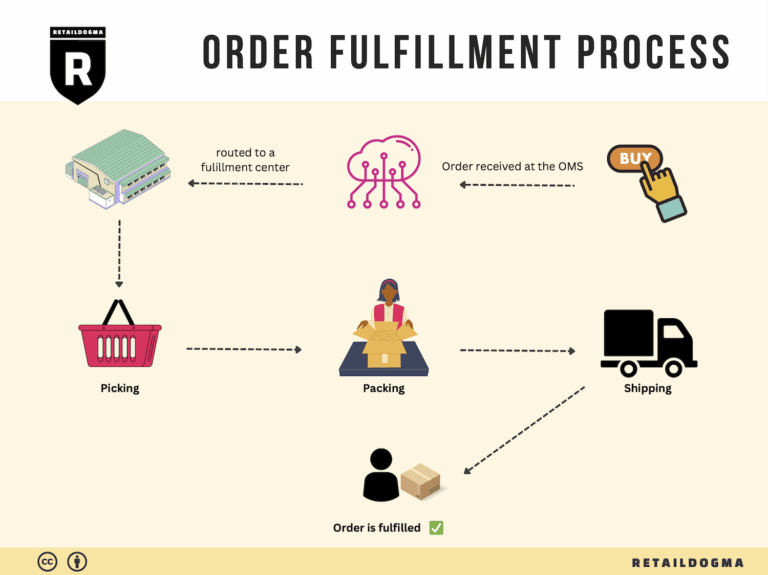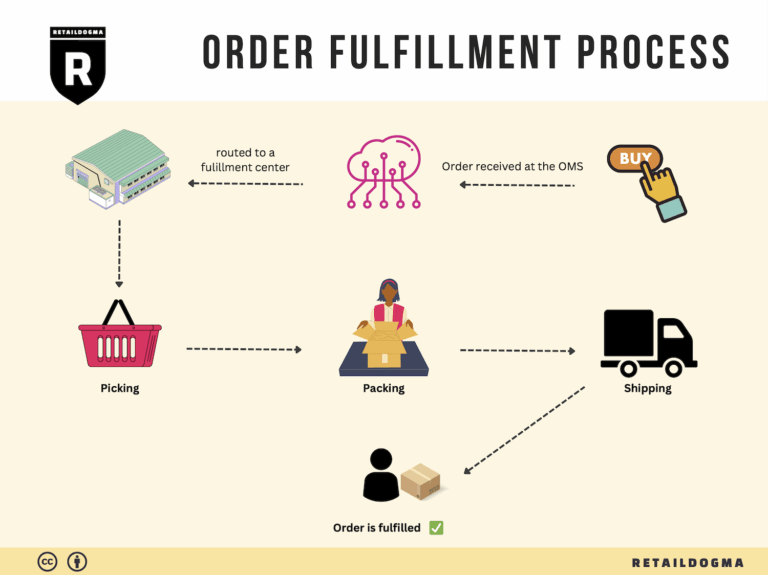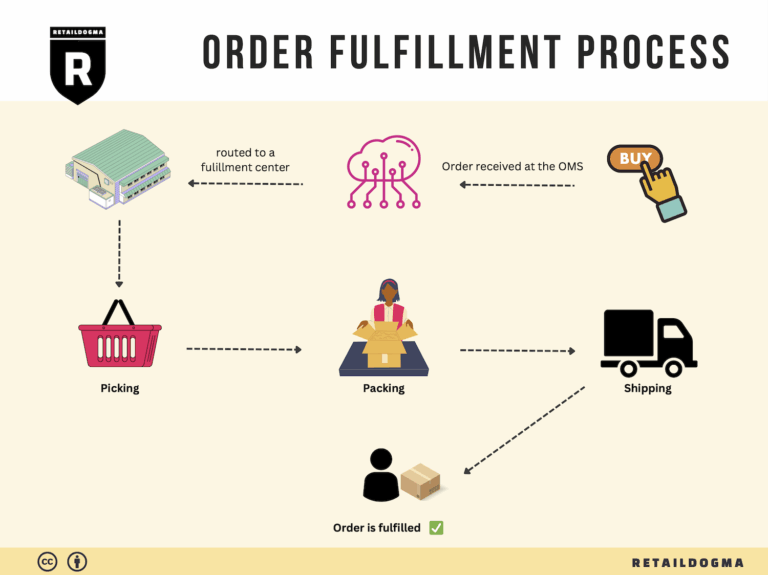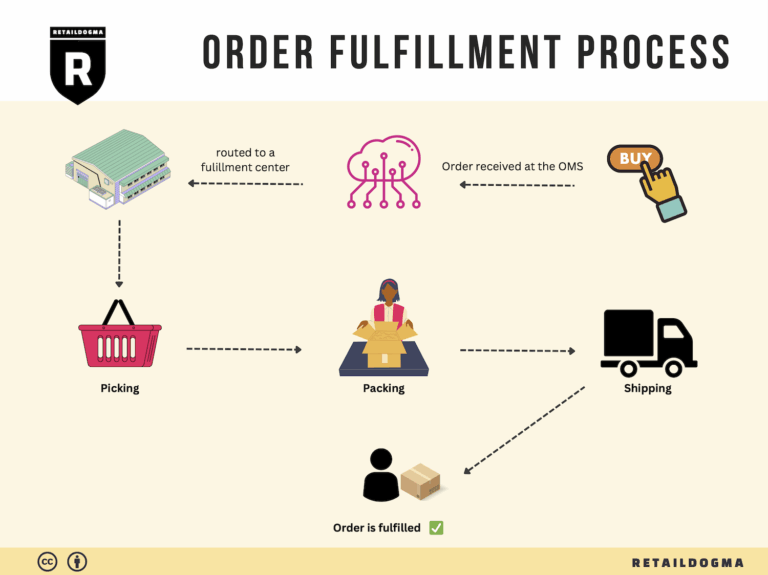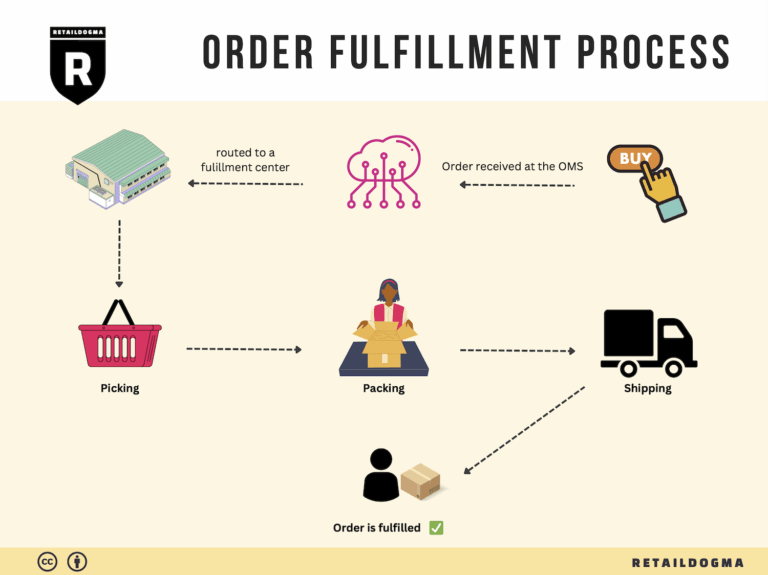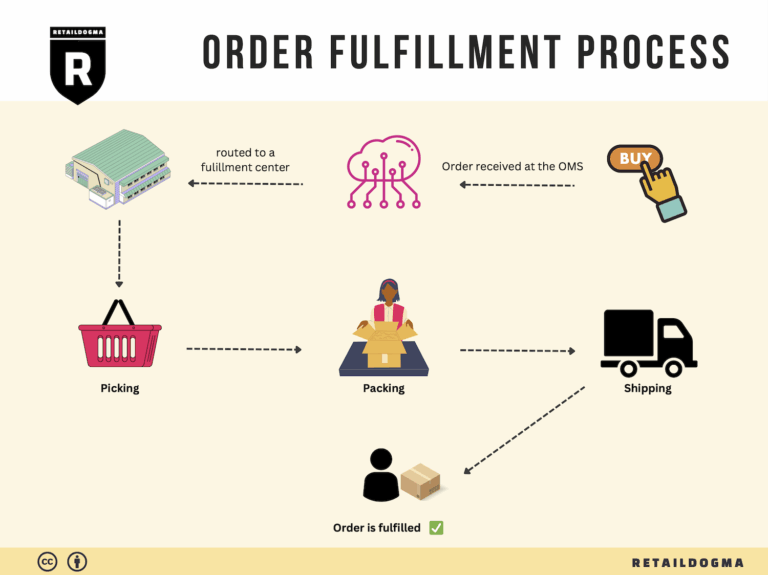How Order Fulfillment Works: A Step-by-Step Guide for Businesses
What is E-commerce Fulfillment? An Introduction for Growing Businesses
Understanding E-commerce Fulfillment: A Necessity for Growing Businesses
As your online business begins to flourish, the excitement of increased sales can quickly turn into the stress of handling logistics. Many e-commerce entrepreneurs find themselves overwhelmed with packing and shipping orders, leading to delays, errors, and customer dissatisfaction. This is where e-commerce fulfillment comes into play, simplifying the process of getting products into the hands of your customers.
At its core, fulfillment is the comprehensive process of receiving, processing, and delivering orders to customers. It encompasses everything from inventory management to shipping logistics. As your business scales, the need for an efficient fulfillment strategy becomes paramount. A well-structured fulfillment operation can significantly enhance your customer experience, streamline your workflow, and ultimately, drive growth.
This guide will explore the various e-commerce fulfillment models available to you, including Third-Party Logistics (3PL) and Fulfillment by Amazon (FBA). Understanding these models will help you determine which best aligns with your business needs. We will also delve into the core services offered by fulfillment partners, such as inventory storage, order processing, and shipping management.
Choosing the right fulfillment partner is critical for your business’s success. We will outline key factors to consider, such as scalability, technology integration, and customer service. Additionally, we will discuss pricing structures, helping you navigate the often complex costs associated with fulfillment services.
By the end of this guide, our goal is to empower you with the knowledge necessary to make informed decisions about your logistics. With the right fulfillment strategy, you can focus on what you do best—growing your business—while ensuring that your customers receive their orders promptly and accurately.
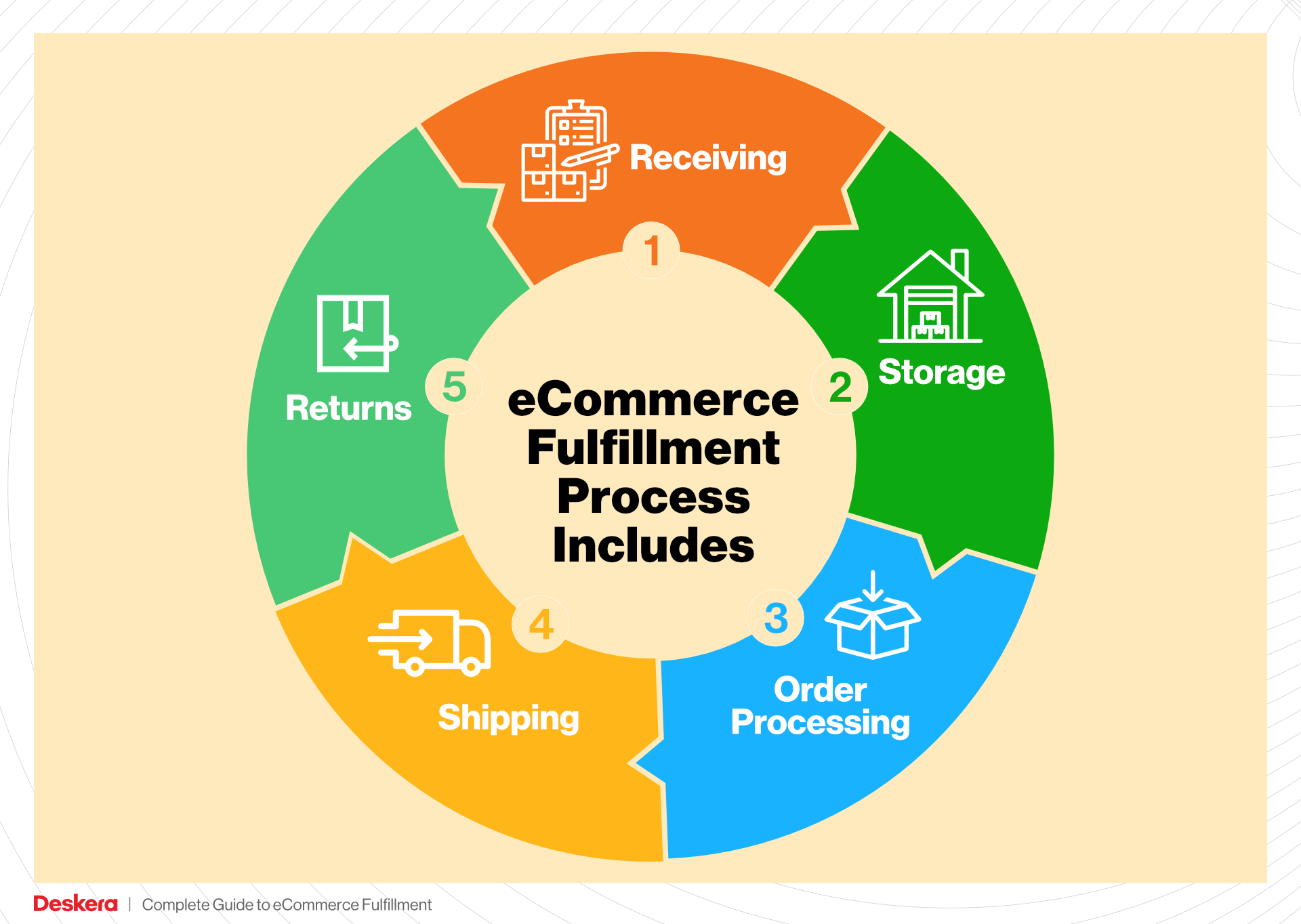
As you embark on this journey, remember that effective fulfillment is not just about getting products shipped; it’s about building a reliable foundation for your e-commerce success. Let’s explore how you can optimize this vital aspect of your operations.
What You’ll Learn In This Guide
- What is E-commerce Fulfillment? An Introduction for Growing Businesses
- The Order Fulfillment Process: From ‘Buy’ Button to Customer’s Door
- Comparing Fulfillment Models: In-House vs. 3PL vs. Dropshipping
- A Deep Dive into Amazon FBA: Pros, Cons, and Who It’s For
- Core Services Offered by Fulfillment Centers
- How to Choose a Fulfillment Partner: A 6-Point Checklist
- Understanding Fulfillment Pricing: A Breakdown of Common Fees
- Frequently Asked Questions (FAQs) about Fulfillment
- Conclusion: Is Outsourcing Fulfillment the Right Move for Your Business?
- Important Disclaimer
The Order Fulfillment Process: From ‘Buy’ Button to Customer’s Door
1. Receiving Inventory
The order fulfillment process begins with receiving inventory, a critical step where products are checked in upon arrival at the fulfillment center. During this phase, each item is inspected for quality and accuracy against purchase orders. This ensures that the correct quantities and types of products are received, minimizing discrepancies that could lead to stockouts or order fulfillment errors.
Key Term: SKU (Stock Keeping Unit)
A SKU is a unique identifier assigned to each product, facilitating accurate tracking and inventory management. Efficient receiving practices help maintain high inventory accuracy rates—Aero Fulfillment boasts a 99.89% inventory accuracy rate, which is vital for building trust with customers and ensuring that the right products are available when orders are placed.
2. Warehouse Storage
Once inventory is received, it is stored strategically in the warehouse. Proper warehouse storage involves categorizing and organizing items based on various factors such as size, weight, and demand frequency. Utilizing a well-planned storage system allows for efficient space utilization and quick access to products when orders are placed.
Key Term: Bin Location
A bin location refers to a designated space within the warehouse where specific items are stored. Effective use of bin locations can significantly reduce order picking times, thus enhancing overall fulfillment speed. By centralizing inventory in a single location, like Aero’s Cincinnati facility, businesses can streamline operations and cut costs associated with multi-facility setups.
3. Order Picking
Order picking is the process of selecting items from their storage locations to fulfill a customer order. This step is crucial as it directly impacts order accuracy and speed. Warehouse staff use tools such as pick lists, which outline the items needed for each order, to ensure that the correct products are retrieved.

Key Term: Pick List
A pick list is a document that guides warehouse workers in selecting the right items for an order. By optimizing the order picking process, businesses can achieve high order accuracy rates—Aero Fulfillment reports a 99.90% order accuracy rate—thereby enhancing customer satisfaction and loyalty.
4. Order Packing
After items are picked, they are moved to the packing station, where they are prepared for shipment. This involves checking the picked items against the order to confirm accuracy, followed by securely packaging them to prevent damage during transit. Proper packing is essential to ensure that products arrive at the customer’s doorstep in pristine condition.
Key Term: Packing Slip
A packing slip is a document included in the package that lists the items being shipped. It serves as a receipt for the customer and helps verify that the correct products have been included. By maintaining high standards in order packing, businesses can reduce return rates and improve overall customer experience.
5. Shipping & Delivery
The final step in the order fulfillment process is shipping and delivery. This phase involves selecting the most efficient shipping method based on factors like delivery speed and cost. Companies like Aero Fulfillment utilize a “Best Way Freight” approach to ensure that shipments are routed using the most economical and timely options available.
Key Term: Carrier Network
A carrier network consists of the various shipping partners used to deliver products to customers. By leveraging a comprehensive carrier network, businesses can optimize shipping costs and enhance delivery speed. Aero’s strategic location and partnerships allow for efficient shipping, often achieving delivery within three days to the lower 48 states, which is crucial for meeting customer expectations.
In summary, understanding and effectively managing each step of the order fulfillment process—from receiving inventory to shipping and delivery—can significantly impact a business’s ability to scale. Implementing best practices in these areas not only improves operational efficiency but also enhances customer satisfaction, ultimately driving growth in the competitive e-commerce landscape.
Comparing Fulfillment Models: In-House vs. 3PL vs. Dropshipping
Fulfillment Model Comparison
| Model | Who Handles Inventory | Best For (Business Stage) | Key Advantage | Key Disadvantage |
|---|---|---|---|---|
| In-House Fulfillment | Business itself | Established businesses | Complete control over inventory and processes | High overhead costs and resource demands |
| Third-Party Logistics (3PL) | External fulfillment partner | Growing businesses | Scalability and reduced operational burden | Potential loss of control over logistics |
| Dropshipping | Supplier or manufacturer | Startups and small businesses | Low startup costs and minimal risk | Lower profit margins and reliance on suppliers |
In-House Fulfillment
In-house fulfillment refers to a logistics model where a business manages all aspects of its order fulfillment internally. This includes handling inventory, warehousing, order processing, and shipping. Established businesses often opt for this model because it allows for greater control over the supply chain and customer experience. By managing inventory directly, businesses can ensure high order accuracy and maintain strict quality control. Additionally, in-house fulfillment enables businesses to tailor their processes and workflows to meet specific operational needs.
However, this model is not without its challenges. The overhead costs associated with maintaining a warehouse, hiring staff, and investing in technology can be significant. Businesses must also be prepared to handle fluctuations in demand, which may require additional labor or storage solutions. In-house fulfillment can strain resources, especially during peak seasons or growth periods. Therefore, while this model can provide substantial control and efficiency, it requires considerable investment and operational capacity.
Third-Party Logistics (3PL)
Third-party logistics (3PL) involves outsourcing fulfillment operations to a specialized logistics provider. This model is ideal for growing businesses that want to scale their operations without the burden of managing logistics in-house. A 3PL provider handles everything from warehousing to shipping, allowing businesses to focus on their core competencies, such as marketing and product development.
One of the key advantages of using a 3PL is scalability. As demand increases, businesses can leverage the expertise and resources of the logistics partner to expand their operations quickly. Additionally, 3PL providers often have established relationships with carriers, enabling them to negotiate better shipping rates and improve delivery times. For example, Aero Fulfillment Services offers centralized inventory management and innovative technology to streamline the fulfillment process.
Despite these benefits, partnering with a 3PL can lead to a loss of control over the logistics process. Businesses may find it challenging to communicate their specific needs and ensure that the 3PL adheres to their standards. Additionally, reliance on a third party can create risks related to service quality, which may ultimately impact customer satisfaction. Therefore, businesses must carefully evaluate potential 3PL partners to ensure alignment with their operational goals.
Dropshipping
Dropshipping is a fulfillment model where retailers do not hold inventory but instead partner with suppliers who ship products directly to customers on their behalf. This model is particularly attractive to startups and small businesses due to its low startup costs and minimal risk. With dropshipping, businesses can offer a wide variety of products without the financial burden of purchasing inventory upfront.
The primary advantage of dropshipping is the reduced financial risk. Since businesses only pay for products after they are sold, they can maintain a lean operation and avoid the costs associated with warehousing and inventory management. This flexibility allows entrepreneurs to test new products and markets without significant investment.
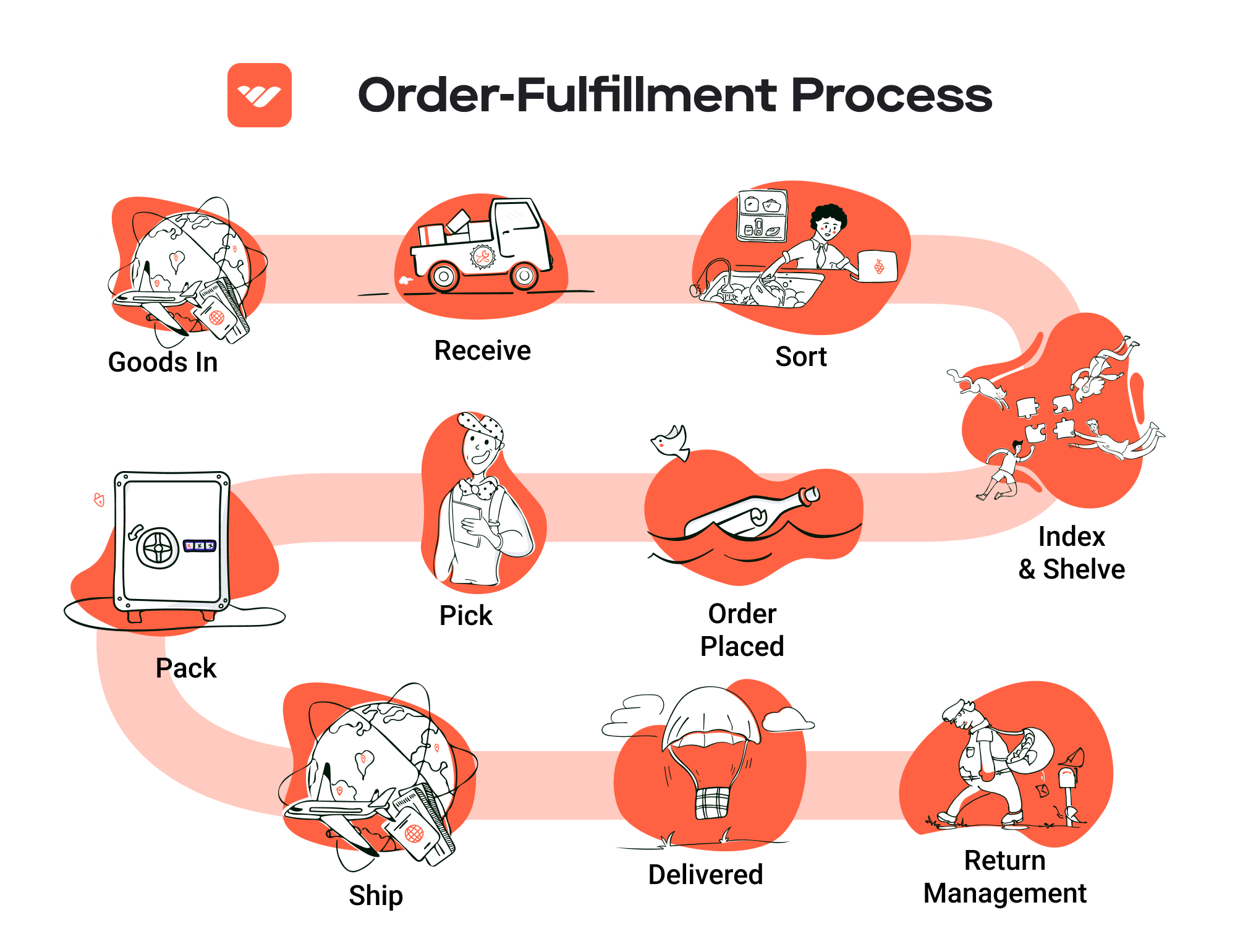
However, dropshipping also presents several challenges. Profit margins can be lower compared to traditional fulfillment models, as suppliers often charge higher prices for the convenience of handling logistics. Additionally, businesses have less control over product quality and shipping times, which can lead to customer dissatisfaction. Reliance on suppliers can also create vulnerabilities, such as stockouts or delayed shipments, which can harm the business’s reputation. Therefore, while dropshipping offers an accessible entry point into e-commerce, it requires careful supplier selection and effective management to ensure customer satisfaction.
In summary, each fulfillment model has its unique advantages and disadvantages, making it crucial for business owners to consider their specific needs, operational capacity, and long-term goals when choosing the right approach for their e-commerce operations.
A Deep Dive into Amazon FBA: Pros, Cons, and Who It’s For
Understanding Fulfillment by Amazon (FBA)
Fulfillment by Amazon (FBA) is a service provided by Amazon that allows sellers to store their products in Amazon’s fulfillment centers. Amazon takes care of storage, packaging, shipping, and customer service for these products. Sellers can benefit from Amazon’s vast logistics network and customer base, allowing them to focus on other aspects of their business, such as marketing and product development.
How FBA Works
-
Product Listing and Setup: Sellers create product listings on Amazon and opt for FBA. They prepare their products according to Amazon’s guidelines, including labeling and packaging.
-
Shipping to Amazon: Once the products are ready, sellers ship their inventory to Amazon’s designated fulfillment centers. Amazon provides shipping labels and instructions to streamline this process.
-
Storage: The products are stored in Amazon’s warehouses. Sellers can track their inventory through Amazon Seller Central.
-
Order Fulfillment: When a customer places an order, Amazon picks, packs, and ships the product directly to the customer.
-
Customer Service: Amazon handles customer inquiries, returns, and refunds for FBA orders, which can significantly reduce the workload for sellers.
-
Payment: Sellers receive payments for their sales, minus Amazon’s fees, which are deducted from the sales revenue.
Pros of Fulfillment by Amazon (FBA)
1. Prime Eligibility
One of the most significant advantages of FBA is that products become eligible for Amazon Prime. This means they can reach millions of Prime members who are often more likely to purchase items that offer free two-day shipping. This can lead to increased sales and visibility.
2. Trust and Credibility
Products fulfilled by Amazon benefit from the trust associated with the Amazon brand. Customers are more likely to purchase items that they know will be handled by Amazon, reducing concerns about shipping and customer service.
3. Multi-Channel Fulfillment
FBA allows sellers to use Amazon’s fulfillment services not just for sales made on Amazon but also for orders from other sales channels, such as eBay or their own websites. This can streamline operations and reduce the complexity of managing multiple fulfillment processes.
4. Scalability
FBA enables businesses to scale quickly without the need to invest in their own warehousing or logistics. As sales increase, sellers can send more inventory to Amazon without worrying about the logistics of storing and shipping products themselves.
5. Efficient Logistics
Amazon’s advanced logistics network allows for efficient order processing and shipping. Sellers can leverage Amazon’s expertise in logistics, which includes sophisticated inventory management and shipping options.
Cons of Fulfillment by Amazon (FBA)
1. High Fees
One of the primary drawbacks of FBA is the cost associated with the service. Amazon charges various fees, including storage fees for holding inventory and fulfillment fees for picking, packing, and shipping orders. These fees can add up quickly, especially for sellers with lower margins.
2. Strict Inventory Rules
Amazon has stringent policies regarding inventory management. Sellers must adhere to specific guidelines for packaging and labeling, and failing to comply can result in additional fees or penalties. Moreover, sellers may face restrictions on the amount of inventory they can send to Amazon based on their sales performance.
3. Commingling Risks
FBA operates on a commingled inventory model, meaning that products from different sellers can be stored together. This can lead to issues if customers receive the wrong items or if there are discrepancies in inventory management. Sellers may find it challenging to ensure that their products are correctly identified and shipped.
4. Limited Control Over Customer Experience
While Amazon handles customer service for FBA orders, this also means that sellers have limited control over the customer experience. Any issues with fulfillment or customer service can reflect poorly on the seller, even if they are not directly involved in the process.
5. Dependency on Amazon
By relying on FBA, sellers become dependent on Amazon’s policies and procedures. Any changes to Amazon’s terms of service, fees, or fulfillment processes can significantly impact a seller’s business.
Who is FBA Best For?
Fulfillment by Amazon is best suited for:
- Small to Medium-Sized Businesses: Sellers who lack the resources to manage their own fulfillment operations can benefit from Amazon’s infrastructure.
- High-Volume Sellers: Businesses with a steady sales volume can take advantage of FBA’s efficiencies and potentially offset the high fees through increased sales.
- Sellers Looking to Expand: Companies aiming to reach a broader audience and leverage Amazon’s vast customer base can find FBA an effective way to scale operations.
- E-commerce Entrepreneurs: New sellers who want to test the market without investing heavily in logistics can utilize FBA to minimize risk and focus on growth.
In conclusion, while FBA offers numerous benefits that can help e-commerce businesses streamline their operations and expand their reach, it’s essential to carefully consider the associated costs and potential drawbacks. Understanding these factors can help business owners make informed decisions about whether FBA aligns with their goals and operational capabilities.
Core Services Offered by Fulfillment Centers
Inventory Management & Warehousing
Inventory management and warehousing are foundational services provided by fulfillment centers, designed to optimize the storage and tracking of products. Fulfillment centers maintain a centralized inventory system that allows businesses to monitor stock levels in real-time. This system integrates with e-commerce platforms to provide accurate data on inventory status, which is crucial for making informed purchasing decisions.
Benefits:
– Reduced Stockouts and Overstocks: By leveraging advanced inventory tracking technologies, fulfillment centers help businesses maintain optimal stock levels. This minimizes the risk of stockouts, which can lead to lost sales, and overstock situations that tie up capital and increase storage costs.
– Centralized Storage: Having a single storage location simplifies logistics. Businesses can streamline their supply chain operations, reducing shipping times and costs. A centralized warehouse also enables quicker response times to market demands.
– Data-Driven Insights: Fulfillment centers provide valuable analytics on inventory performance, allowing businesses to forecast demand accurately. This data can inform purchasing strategies and promotional planning, leading to improved sales and customer satisfaction.
Pick and Pack Services
Pick and pack services involve the process of selecting products from inventory (picking) and preparing them for shipment (packing). Fulfillment centers utilize efficient systems and trained staff to ensure that orders are processed quickly and accurately. This service is essential for e-commerce businesses that rely on timely deliveries to enhance customer experience.
Benefits:
– Order Accuracy: High accuracy rates in picking and packing are critical for maintaining customer satisfaction. Fulfillment centers often achieve near-perfect accuracy, which reduces the likelihood of returns and enhances brand loyalty.
– Scalability: As businesses grow, their order volumes can fluctuate significantly. Fulfillment centers provide scalable pick and pack services that can adapt to seasonal demand spikes without compromising service quality.
– Time Savings: Outsourcing pick and pack operations allows businesses to focus on core activities such as marketing and product development. This delegation of logistics tasks can lead to increased efficiency and growth.
Kitting and Assembly
Kitting and assembly services involve the grouping of individual items into ready-to-sell sets or the assembly of components into a finished product. This service is particularly beneficial for e-commerce businesses that offer bundles, subscription boxes, or customized products. Fulfillment centers can handle the complexity of kitting and assembly, ensuring that products are prepared correctly before shipping.
Benefits:
– Enhanced Product Offerings: By offering bundled products or customizable kits, businesses can increase average order values and attract new customer segments. Fulfillment centers simplify this process, enabling businesses to test new product combinations without significant upfront investment.
– Efficiency in Production: Kitting and assembly services streamline operations by consolidating multiple SKUs into a single shipment. This reduces handling time and shipping costs, improving overall supply chain efficiency.
– Quality Control: Fulfillment centers implement quality control measures during the kitting and assembly process, ensuring that products meet the expected standards before reaching the customer. This attention to detail can enhance brand reputation and customer satisfaction.
Returns Management (Reverse Logistics)
Returns management, or reverse logistics, refers to the processes involved in handling returned products. Fulfillment centers provide comprehensive returns management services that include receiving, inspecting, restocking, and processing refunds or exchanges. This service is vital for e-commerce businesses, where return rates can be significantly higher than in traditional retail.
Benefits:
– Streamlined Returns Process: A well-organized returns management system ensures that returns are processed quickly and efficiently. This can significantly improve customer satisfaction, as customers appreciate hassle-free return experiences.
– Cost Reduction: By efficiently managing returns, fulfillment centers can help businesses reduce the costs associated with reverse logistics. This includes minimizing the time and resources spent on processing returns and restocking items.
– Data Insights on Returns: Fulfillment centers can provide valuable analytics on return reasons and trends. Understanding why customers return products can help businesses make data-driven decisions to improve product quality, descriptions, and customer expectations.
In summary, partnering with a fulfillment center that offers robust inventory management, efficient pick and pack services, kitting and assembly capabilities, and effective returns management can significantly enhance an e-commerce business’s operations. These core services not only streamline logistics but also contribute to improved customer satisfaction and overall business growth. By outsourcing these functions, e-commerce businesses can focus on their strategic goals while ensuring that their logistics operations are handled by experts.
How to Choose a Fulfillment Partner: A 6-Point Checklist
Location & Warehouse Network
The geographical location of your fulfillment partner can significantly impact shipping costs and delivery times. A strategically placed warehouse network ensures faster shipping to your customer base, which is crucial for maintaining high customer satisfaction.
Questions to Ask:
– Where are your warehouses located, and how does that align with my target market?
– Can you provide shipping times and costs for various regions?
– What is your strategy for managing inventory across multiple locations, if applicable?
Technology & Integrations
A robust technological infrastructure is essential for seamless operations. Your fulfillment partner should offer advanced technology that integrates with your existing e-commerce platforms, enabling real-time inventory tracking, order processing, and analytics.
Questions to Ask:
– What technology do you use for inventory management and order fulfillment?
– Can your systems integrate with my existing e-commerce platforms (e.g., Shopify, WooCommerce)?
– How do you ensure data security and compliance with regulations like GDPR?
Specializations (e.g., Cold Storage, Oversized Items)
Different businesses have unique needs, such as handling temperature-sensitive products or oversized items. It’s crucial to partner with a fulfillment provider that specializes in your specific requirements.
Questions to Ask:
– Do you have experience handling products similar to mine (e.g., perishables, large items)?
– What specific facilities or equipment do you have for specialized storage?
– Can you provide case studies or references from similar clients?
Scalability & Capacity
As your business grows, your fulfillment partner must be able to scale operations accordingly. Understanding their capacity and scalability options will help ensure you are not left scrambling during peak seasons or growth spurts.
Questions to Ask:
– What is your current capacity, and how quickly can you scale if my order volume increases?
– Do you have systems in place to handle seasonal fluctuations in demand?
– How do you manage labor and resources during peak times?
Pricing and Contracts
Understanding the pricing structure and contract terms is vital for budgeting and financial planning. Look for transparency in pricing and ensure there are no hidden fees that could impact your bottom line.
Questions to Ask:
– Can you provide a detailed breakdown of your pricing structure, including storage, handling, and shipping costs?
– What are your contract terms, and is there flexibility for renegotiation?
– Are there any additional fees for services like returns management or special handling?
Customer Support & Reviews
Reliable customer support is key to a successful partnership. A responsive and knowledgeable support team can help you navigate challenges and ensure smooth operations. Additionally, researching customer reviews can provide insights into the partner’s reliability and service quality.
Questions to Ask:
– What support options do you offer (e.g., dedicated account manager, 24/7 support)?
– How do you handle issues or discrepancies in order fulfillment?
– Can you provide references or case studies from current or past clients?
Conclusion
Choosing the right fulfillment partner is a critical decision that can greatly affect your e-commerce business’s efficiency and customer satisfaction. By using this checklist, you can systematically evaluate potential partners to ensure they align with your specific needs and growth aspirations. Always remember to prioritize transparency, communication, and a shared vision for success when making your final decision.
Understanding Fulfillment Pricing: A Breakdown of Common Fees
Initial Setup Fees
When partnering with a fulfillment service, businesses often encounter initial setup fees. These are one-time charges associated with integrating your e-commerce platform with the fulfillment provider’s systems. This process may involve software configuration, inventory setup, and training your team on the new systems.
The calculation of initial setup fees can vary significantly between providers. Some may charge a flat fee, while others might base their charges on the complexity of the integration, the number of SKUs, or the volume of orders anticipated. It’s essential to clarify what is included in these fees—such as IT support or onboarding assistance—to avoid unexpected costs.
Receiving Fees
Receiving fees are incurred when the fulfillment center accepts your inventory. This fee covers the labor and resources needed to unload shipments, inspect items for quality, and enter them into the inventory management system.
Typically, receiving fees are calculated per shipment or per hour worked, depending on the volume and nature of the items being received. For instance, if you send a large shipment of bulky items, the provider may charge based on the total weight or volume of the shipment. Smaller, more frequent shipments might incur a flat fee. Be sure to inquire about how these fees are structured, especially if your business model involves frequent inventory turnover.
Storage Fees (per pallet/bin)
Storage fees are recurring charges for keeping your inventory in the fulfillment center. These fees can be charged on a per-pallet or per-bin basis, depending on how your inventory is organized within the warehouse.
Calculating storage fees often involves a monthly rate multiplied by the number of pallets or bins utilized. Some fulfillment providers may also implement tiered pricing, where the rate decreases as you store larger volumes. It’s important to consider seasonality in your business, as fluctuations in inventory levels may lead to significant variances in storage costs. Make sure to review the fulfillment center’s policies on minimum storage durations and any penalties for exceeding agreed-upon limits.
Pick & Pack Fees (per item/order)
Pick and pack fees are charged for the labor involved in selecting items from inventory and packing them for shipment. This fee structure can be based on the number of items per order or a flat rate per order.
For example, if you sell a product with multiple variations, each item selected might incur a separate fee, increasing costs for more complex orders. Conversely, some providers might offer a bulk rate for larger orders, which can be cost-effective for businesses with high sales volumes. Understanding how these fees are applied is crucial to maintaining control over your fulfillment costs, especially as you scale.
Shipping Fees
Shipping fees are one of the most significant components of fulfillment pricing and can vary widely based on factors such as shipment weight, dimensions, destination, and the chosen carrier. Fulfillment providers often negotiate shipping rates with carriers due to their high shipping volumes, allowing them to pass on savings to you.
Shipping fees can be calculated using various methods, including flat rates, zone-based pricing, or weight-based pricing. Ensure that you understand how your fulfillment partner calculates these fees and whether they offer options for expedited shipping or other services that might affect your overall costs. Additionally, consider how shipping fees impact your pricing strategy and customer satisfaction.
Tips for Getting an Accurate Quote
-
Be Transparent About Your Needs: Clearly communicate your business model, order volume, and inventory types to potential fulfillment partners. The more information you provide, the more accurate their quote will be.
-
Request a Detailed Breakdown: Ask for a detailed pricing structure that outlines all potential fees. This helps you identify any hidden costs and enables you to make informed comparisons between providers.
-
Consider Seasonal Variations: If your business experiences seasonal spikes in demand, inquire about how these fluctuations affect pricing and whether the provider can accommodate these changes without significant surcharges.
-
Evaluate Service Levels: Different providers may offer varying levels of service, which can impact costs. Assess what is included in their services, such as inventory management technology, customer service, and flexibility in handling special requests.
-
Negotiate Terms: Don’t hesitate to negotiate terms, especially if you have a solid understanding of your shipping volumes and expected growth. Many fulfillment centers are willing to adjust pricing for long-term partnerships.
By understanding these common fees and employing these tips, e-commerce business owners can better navigate the complexities of fulfillment pricing and choose the right partner to support their growth.
Frequently Asked Questions (FAQs) about Fulfillment
1. What is Aero Fulfillment Services, and how can it benefit my e-commerce business?
Aero Fulfillment Services is a third-party logistics (3PL) provider located in Cincinnati, Ohio, specializing in e-commerce order fulfillment and warehousing. By partnering with Aero, businesses can streamline their logistics, reduce shipping costs, and improve order accuracy and customer satisfaction. Aero’s centralized inventory and advanced technology enable faster delivery and more efficient operations, allowing you to focus on scaling your sales.
2. What is the difference between a warehouse and a fulfillment center?
While both warehouses and fulfillment centers are used for storage, their functions differ significantly. A warehouse primarily focuses on storing goods, often for long periods. In contrast, a fulfillment center specializes in processing and shipping orders directly to customers. Fulfillment centers, like Aero, also handle inventory management, order picking, packing, and shipping, ensuring timely delivery and customer satisfaction.
3. What is a 3PL, and how does it work?
A third-party logistics (3PL) provider manages a company’s logistics and supply chain operations. This includes warehousing, inventory management, order fulfillment, and shipping. Partnering with a 3PL like Aero allows e-commerce businesses to leverage specialized expertise and resources, leading to increased efficiency, reduced costs, and improved service levels without the need for in-house logistics management.
4. How much do fulfillment services cost?
Fulfillment service costs can vary widely based on factors such as order volume, storage space, shipping methods, and additional services like kitting or returns management. Aero Fulfillment Services offers customized pricing based on your specific needs, ensuring you receive a solution that fits your budget while maximizing efficiency.
5. How does Aero ensure order and inventory accuracy?
Aero Fulfillment Services maintains a high level of order accuracy (99.90%) and inventory accuracy (99.99%) through rigorous processes and technology integration. Their advanced systems track inventory in real time, and the Client Experience Team conducts regular reviews and huddles to address any issues promptly, ensuring that your orders are processed accurately and efficiently.
6. Can Aero handle seasonal spikes in order volume?
Yes, Aero Fulfillment Services is equipped to manage fluctuations in order volume, thanks to their scalable operations and proactive planning. Their experienced team and technology allow them to adapt to seasonal demands, ensuring that your business can meet customer expectations even during peak periods.
7. What shipping options does Aero provide?
Aero Fulfillment Services utilizes a “Best Way Freight” approach, allowing them to choose the most efficient shipping method for each order. This includes less-than-truckload (LTL), full-truckload (FTL), and parcel delivery. By leveraging their extensive carrier network, Aero ensures timely deliveries at competitive rates, ultimately enhancing customer satisfaction.
8. How quickly can I get started with Aero Fulfillment Services?
Aero Fulfillment Services can have you up and running in as little as 30 days. Their streamlined onboarding process and dedicated support team ensure a smooth integration with your existing systems, allowing you to start benefiting from their fulfillment solutions without significant delays.
9. What kind of visibility will I have into my fulfillment operations?
Aero provides comprehensive visibility into your fulfillment operations through their advanced technology platform. Clients can access real-time data on order status, inventory levels, and performance metrics. Regular meetings with your Client Experience Representative also ensure that you stay informed and aligned with your fulfillment goals.
10. How does Aero handle customer service and support?
Aero Fulfillment Services places a strong emphasis on customer support through their dedicated Client Experience Team. This team advocates for your business daily, ensuring that your specific needs are met and any challenges are addressed promptly. Regular communication and proactive management help maintain a high level of service and satisfaction.
Conclusion: Is Outsourcing Fulfillment the Right Move for Your Business?
The Advantages of Outsourcing Fulfillment
Outsourcing fulfillment can be a game-changer for e-commerce businesses aiming to scale efficiently. By leveraging a specialized fulfillment service, businesses can save significant time and resources that would otherwise be spent managing logistics. This allows you to focus on core activities such as marketing, product development, and customer engagement, which are crucial for growth.
One of the primary advantages of partnering with a fulfillment service is scalability. As your business grows, so do your fulfillment needs. A reliable fulfillment partner can adapt to fluctuating order volumes, seasonal spikes, and new product launches without the headaches associated with managing these changes in-house. This flexibility not only streamlines operations but also enhances your overall customer experience by ensuring timely deliveries.
Moreover, working with an experienced fulfillment provider grants access to industry expertise and advanced technology. This includes optimized shipping solutions, inventory management systems, and performance metrics that can help you refine your operations. The right partner will not only meet your current needs but will also be proactive in identifying opportunities for improvement and cost savings.
Choosing the Right Partner
However, the success of outsourcing fulfillment hinges on selecting the right partner. A poor choice can lead to diminished quality, late orders, and unhappy customers, all of which can hinder your growth. It’s essential to conduct thorough due diligence, ensuring that your potential partner aligns with your business goals and operational requirements.
Take Action
To determine if a fulfillment partner is the right next step for your business, consider auditing your current shipping and fulfillment processes. Evaluate areas where delays occur or costs are higher than expected. This assessment will provide clarity on whether outsourcing is a strategic move that can propel your business forward. If you find gaps in your current system, it may be time to explore partnerships with fulfillment services like Aero Fulfillment that can enhance your logistics and customer satisfaction.
Important Disclaimer
⚠️ Important Disclaimer
The information in this guide is for educational purposes. Fulfillment services, pricing, and platform features change frequently. Always conduct your own due diligence and consult with providers directly before making business decisions.

